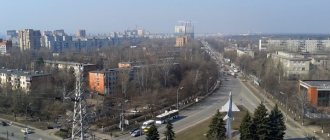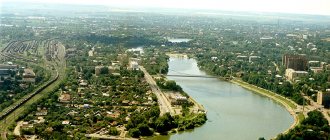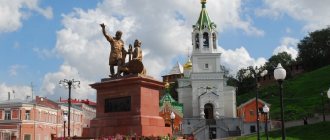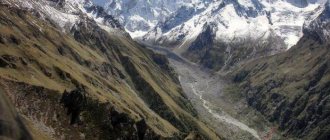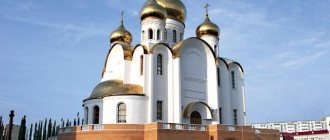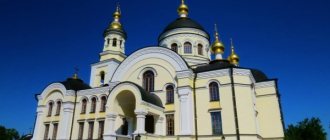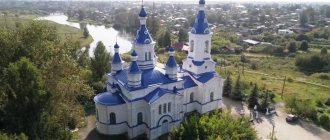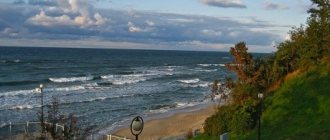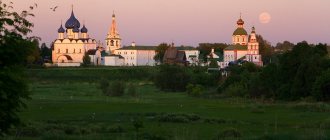Coat of arms of the urban district of Vyksa
The coat of arms of the urban district of the city of Vyksa, Nizhny Novgorod region is the official symbol of the urban district of the city of Vyksa, Nizhny Novgorod region.
Heraldic description of the coat of arms of the city district:
“In a four-part field of scarlet, green, azure and scarlet is a rising silver unicorn.”
Decision of the Council of Deputies of the urban district of the city of Vyksa dated 02/28/2017 No. 7 “On the coat of arms of the urban district of the city of Vyksa of the Nizhny Novgorod region”
Flag of the Vyksa urban district
The flag of the urban district of the city of Vyksa of the Nizhny Novgorod region is the official symbol of the urban district of the city of Vyksa of the Nizhny Novgorod region.
Description of the city district flag:
“A rectangular double-sided panel with a width to length ratio of 2:3, composed of 4 equal rectangular parts, red and green at the top, blue and red at the bottom. In the center of the panel, the figure of a white unicorn from the coat of arms of the urban district of the city of Vyksa, Nizhny Novgorod region, is reproduced.”
Decision of the Council of Deputies of the urban district of the city of Vyksa dated 02.28.2017 No. 8 “On the flag of the urban district of the city of Vyksa of the Nizhny Novgorod region”
Charter of the urban district of the city of Vyksa dated 07/04/2016
Date of foundation of the city of Vyksa 1934
City Day: last Sunday in July
Population of the city: 58 thousand 635 people.
The distance from the city of Vyksa to the regional center - Nizhny Novgorod - along the highway is 186 km, the nearest railway station Navashino is 28 km from the regional center.
The territory of the Vyksa Okrug is 186.5 thousand hectares. The population of the district is 83 thousand people
The population density is 50 people per square kilometer.
Vyksa
The city of Vyksa, Vyksa district, is located in the Priokskaya lowland and is part of the Prioksky southwestern lowland Polesie region. Its territory is 184.3 thousand hectares. The region borders the Ryazan region in the south and the Vladimir region in the west. In the north and northeast of it are Navashinsky and Kulebaksky, and in the east and southeast are the Ardatovsky and Voznesensky districts of the Nizhny Novgorod region. In total, there are 46 settlements in the Vyksa region.
The center of the district is the industrial city of Vyksa, whose area is 2124 hectares. The distance from the city of Vyksa to the regional center - Nizhny Novgorod - along the highway is 186 km. You can get to Vyksa along the Oka, but it’s more convenient by rail to Navashino station, and from there it’s 28 km to the city by bus “Vyksa – Navashino”.
Currently, Vyksa is not only the administrative center of the Vyksa district, but also a large industrial city in the Nizhny Novgorod region. Most of the region's industrial enterprises are located in Vyksa. By 2000, in addition to streets and alleys, entire microdistricts had grown up in the city: Gogol, Yubileiny, Zhukovsky, Central, Yuzhny. A special feature of Vyksa is that it is surrounded by large factory villages, now settlements, part of the population of which worked and is working in Vyksa.
Vyksa is the eighth most populous district of the Nizhny Novgorod region. The population is 93.8 thousand people, which is approximately 3% of the total number of residents of the region. Population density is 50 people per square kilometer. Most of the population (66.8%) lives in the city of Vyksa. In terms of national composition, Russians predominate. Currently, the population of the city of Vyksa is 57 thousand 911 people.
Climate
Vyksa has a milder climate than other areas of the region. Winter here is less frosty and snowy. Summer is somewhat cooler than in the southeast of the region. Precipitation averages 523 mm per year. Average annual temperature + 3.7 Cº. The climate of the region is comparable to the climate of the central part of the Russian Plain.
Land fund
The soils are soddy-podzolic, sandy loam and sandy, often swampy and infertile. There are 39 thousand hectares of land in general use, of which more than half is intended for agriculture. If we compare the latest data with the total area of the district, then agricultural land accounts for 16.3% of the territory, including 8.2% occupied by arable land, 4.4% allocated to hayfields and 2.4% to pastures. Land for personal subsidiary plots and individual construction accounts for 1.2%. 2.2% of the land is allocated for squares, streets, roads, and passages.
Minerals
The iron ore strip, located in the south of the Nizhny Novgorod region and running from Vyksa to Cherevatovo and Pervomaisk, originates in the city of Vyksa The ore-bearing stratum of the Vyksa iron ores is close to the surface, but the ore in it occurs in separate nests and does not form a continuous horizontal accumulation. Iron ore contains 30-37% pure iron. The total reserves of iron ore in the Vyksa region are estimated at 2.5 million tons, mainly second-grade ore (class “C” and “B”). The Vyksa ores are similar to the ores of the Tula-Lipetsk deposits, being ores of sedimentary origin. There are two types of ores in the Vyksa deposits - white and red. Both require mandatory roasting before smelting; in order to convert the ores into iron oxides, they are enriched in iron. White ore is the most valuable, easily melted, and richer in iron.
In neighboring Murom, ores from the Oka region have long been used. Already under Peter I in 1721, the latter were registered with the special government department of the Berg Collegium in St. Petersburg; with the construction of factories in the mid-18th century, ores began to be used in very large quantities. Due to unprofitability and relatively small resources, ore mining was stopped in 1923.
On the territory of the region there are 3 deposits of clay raw materials with industrial reserves of about 5 million tons (Vilskoye, Pesochenskoye, Firyusikhinskoye), 2 deposits of sand and gravel material with industrial reserves of about 1.5 million m3 (Konnovskoye, Lyakhovskoye), 2 deposits of carbonate rocks with industrial reserves 900 thousand m (Bachikhanskoye, Shimorskoye). Construction sands are found everywhere. In the southern part of the region there are peat deposits.
Forest land
Before the construction of the factories, that is, two and a half centuries ago, the epic Murom forests “stood like a wall” here. Until the beginning of the 20th century, the famous Murom forests were located on the territory of the region. But they were exterminated for charcoal, firewood and building material, especially during the years of industrialization and after the end of the Great Patriotic War. Gradually, the forests were restored and currently occupy 146.6 thousand hectares, i.e. The current forest cover of the region is 78 percent. Pine predominates on sandy soils. Low wetlands are occupied by aspen and birch trees and are rich in feathered game, animals, fluffy mosses, mushrooms, and berries. Pine predominates in the mixed Vyksa forests. In the old days, “there were a lot of animals here, including bears - the “kings of the forest,” strong and ferocious animals. In the forests and even within the city there are larch, chestnut, etc.
The total timber reserve is 16.7 million cubic meters. m, including 11.3 million cubic meters. m. falls on coniferous species. All forests in the region are classified as forests for water protection and exploitation purposes. The mushroom-bearing area is 11.9 thousand hectares with a biological yield of 400 tons of mushrooms per year. On the territory of the district there is a base for the procurement of forest chemical raw materials.
Hydraulic system
In the west flows the Oka River, whose tributaries are the Snoved, Veletma, Suvod, Vereya and Zheleznitsa rivers. All inland rivers are small, have forest feeding and therefore are relatively high in water all year round. The total spillway area is 1771 square meters. km. The main river of the area is the Zheleznitsa River, the source of which is located in a forest spring behind the village of Pustoshka. The river absorbs many tributaries, including the Vilya and Vyksun rivers.
The Vyksun, merging at the Rizadeya with the tributaries Berezovaya, Yagodnaya, and the Maly Vyksun, feeds water into two reservoirs preserved from the second half of the 19th century - the Upper Pond (area about 250 hectares) and the Lower Pond (38 hectares). It was thanks to the waters of Vyksa, which moved the factory mechanisms for more than two centuries, that the city of Vyksa and its factories appeared. It is no coincidence that of the five largest ponds in the Nizhny Novgorod region, four are located in the Vyksa district: Vilsky, Zapasnoy, Doschatinsky, Verkhevyksunsky. In the area there is part of the unique Yuzhno-Gorkovskoye groundwater deposit, from which water supply is organized for populated areas. There are floodplain and bottom-floodplain lakes in the region.
Fauna
In the animal world, hunting bird species, mammals and commercial fish species are of greatest practical interest. The forests are home to elk, wild boar, foxes, hares, wood grouse, black grouse, and hazel grouse. Professional fishing is widespread in the area of the village of Chupaleyka with economic fishing of live fish of at least 70 tons per year. Favorable natural and climatic conditions contribute to maintaining a fishery stock of at least 300 tons of live fish.
Iversky Monastery
The Vyksa Iversky Monastery was founded in 1863 by the Venerable Elder Hieromonk Varnava. During his lifetime he was greatly revered, and after his death, at the end of the 20th century, he was canonized. Barnabas prompted Nizhny Novgorod merchants to donate funds for the opening of a women's monastery, where he donated the Iveron Icon of the Mother of God, after which the monastery was named.
You may be interested in:Exotic fruits in Bali: review
The place where the monastery was built is called the “chosen heart.” There is a legend in the city that at night people noticed burning candles and bells ringing there. In 1880-1894, the construction of the Cathedral of the Life-Giving Trinity in the Russian-Byzantine style was underway, the architect of which was Pyotr Vinogradov. The monastery complex also includes the main Iversky and Assumption Cathedrals, a bell tower, an almshouse and a large number of outbuildings.
You may be interested in: What to bring from Milan as a souvenir or gift?
One of the reasons for the construction of such a large monastery was that after the reform of 1864, unemployment increased and women's work was paid very low. Poor peasants came to the cities and barely found work. The only way out for many women, especially from the lower strata, was monasteries.
The buildings of this Vyksa landmark took about fifty years to construct. There was enough farming: horse and cattle yards, vegetable gardens, shops, a beekeeper and a candle factory. In 1917, the monastery numbered about 100 nuns and 400 novices. Later the monastery began to be destroyed. In 1919 it was completely closed. In 1924, the brick fence and the entire Iversky Church were dismantled in order to build an outpatient clinic and a city hospital. In 1927, the Trinity Cathedral and bell tower were blown up. At the same time, the nuns did not want to leave their monastery, remaining in the cave cells, which is why during the explosion they were forever buried under the ruins.
Brief history of the city
Vyksa began in 1765, when the Batashov brothers, natives of Tula, discovered deposits of bog iron ore - limonite - in the vicinity of modern Vyksa.
Its development was organized using shallow conical pits - “pipes”. Gradually, three metallurgical plants were built in Vyksa, employing serf workers. The village grew quickly. In its surroundings - Veletma, Doschatoy, Vila - ironworks were also created. For production needs, a system of ponds was organized with an area of up to 585 hectares and a depth of up to 9 m. Vyksa was famous for the skill of metallurgists and the wealth of breeders. They created a magnificent landscape park with a menagerie, greenhouses where citrus fruits were grown in winter, an artificial lake and a theater. The Batashev Palace was built nearby, overlooking the expanses of the Verkhnevyksunsky pond. In Vyksa and its environs, the quadriga of horses and the statue of Apollo that decorate the Bolshoi Theater in Moscow, the equestrian group on the Arc de Triomphe in Moscow, and the lattice of the Alexander Garden near the Kremlin were cast. The factories produced weapons, sheet metal, nails, wire, castings, long iron, and pipes.
In the 19th century. The Vyksa factories changed hands several times, but the new owners were unable to improve technology, production volumes fell, and products lost competitiveness. In the 19th century, the famous playwright A.V. lived and worked in Vyksa with relatives who owned factories. Sukhovo-Kobylin and prose writer E.A. Salias de Tournemire. The latter wrote the popular novel “The Vladimir Monomakhs,” which described the history of the Vyksa factories and their owners.
At the end of the nineteenth century. In Vyksa, the largest narrow-gauge railway system in Russia at that time was being built, connecting factories with ore mining and logging sites. A significant part of them has survived to this day. In particular, narrow-gauge railways are the only connection with the mainland of such villages as Dimara, Novy Lashman, Lesomashinny, Tupik, Domiki. The passenger train consists of 2-3 cars and runs along the routes Lesozavod station - Dimara (with a stop at Novy Lashman) and Unor - Tupik (with a stop at Lesomashinny).
In 1934, Vyksa acquired the status of a city and received a new impetus for development. A large-scale re-equipment of the metallurgy industry is underway: small enterprises (like plants in Vila and Veletma) are being closed or repurposed (in Doschatoye), new ones are coming into operation at the Vyksa plant, equipped with modern equipment, focused only on pigment metallurgy. Factories of crushing and grinding equipment (during the war days it produced armored vehicles), heat-insulating materials plants came into operation, woodworking enterprises and food industry enterprises appeared.
In 1970-1980 The city grew significantly: a pipe production plant came into operation in Vyksa, which served the construction of oil and gas pipelines and the world's largest wheel production. During this period, new residential areas were built in the city, and the development of the center took shape.
The products of the Vyksa Metallurgical Plant are also highly rated abroad: it is a supplier of wheels for railway transport not only in Russia, but also in the USA, South Korea, India, and a number of European countries.



